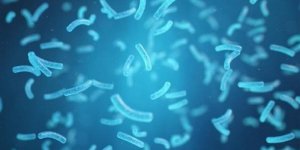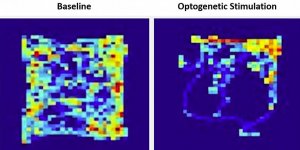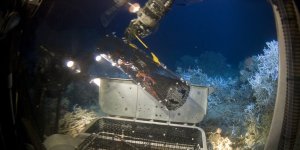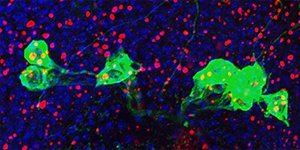Science News

A novel technology was developed by Indian-origin researchers that can clean water twice as fast as commercially available ultrafiltration membranes. »

In the largest study of its kind to date, Cambridge researchers have looked at why some people manage to stay thin while others gain weight easily. They have found that the genetic dice are loaded in favour of thin people and against those at the obese end of the spectrum. »

A new study in rodents has shown that the brain’s cerebellum—known to play a role in motor coordination—also helps control the brain’s reward circuitry. »

Greenland's ice is melting faster than previously thought, according to a new study. »

Using a novel patient-specific stem cell-based therapy, researchers at the National Eye Institute prevented blindness in animal models of geographic atrophy, the advanced "dry" form of age-related macular degeneration. »

A new study employed quantitative spatial analysis to establish that the platforms, or ahu, built to support the Easter Island statues, or moai, are usually located near sources of drinkable water. »

Planetary scientist Vlada Stamenković of the NASA Jet Propulsion Laboratory and colleagues have developed a new chemical model of how oxygen dissolves in Martian conditions, which raises the possibility of oxygen-rich brines; enough, the work suggests, to support simple animals such as sponges. »

As much of the ocean responds to the rising temperatures of today’s world, the deep, dark waters at the bottom of the Pacific Ocean appear to be doing the exact opposite. »

In a study of fruit flies, National Institutes of Health scientists suggested that the body’s immune system may play a critical role in the damage caused by aging brain disorders. »

Policies aimed at removing sweets and crisps from checkouts could lead to a dramatic reduction in the amount of unhealthy food purchased to eat ‘on the go’ and a significant reduction in that purchased to take home, suggests new research led by the University of Cambridge. »

Scientists have found that Bee may be able to count using only four nerve cells as their brains have evolved to be very energy efficient. »

Scientists have genetically modified a common houseplant called pothos ivy or devil’s ivy that can remove chloroform and benzene from the air around it. »

MIT researchers they invented a way to shrink objects to nanoscale by using a laser, meaning they can take any simple structure and reduce it to one 1,000th of its original size. »

An international team of researchers has pieced together a model of the subterranean ecosystem hidden beneath the Earth. »

New study revealed that the Dracula ant or Mystrium camillae, has the fastest animal movement on record as it can snap its mandibles at speeds of up to 90 meters per second, which makes it more than 200 miles per hour. »

Attention training improves intelligence and brain function of children. The benefit is greater if the training is guided by an educator, according to recent research conducted at the University of Granada. »

‘Anhedonia’ (the loss of pleasure) is one of the key symptoms of depression. An important component of this symptom is an inability to feel excitement in anticipation of events; however the brain mechanisms underlying this phenomenon are poorly understood. »

Findings reveal tripling of blood levels of trimethylamine N-oxide from red meat diet, but dietary effects can be reversed »

After performing a systematic study of the antimicrobial properties of a toxin normally found in a South American wasp, researchers at Massachusetts Institute of Technology have now created variants of the peptide that are potent against bacteria but nontoxic to human cells »

Researchers have discovered that a hormone, fibroblast growth factor 21, is extremely elevated in mice with liver disease that mimics the same condition in patients with methylmalonic acidemia, a serious genomic disorder. »

A simple molecule in the atmosphere that acts as a "detergent" to breakdown methane and other greenhouse gases has been found to recycle itself to maintain a steady global presence in the face of rising emissions, according to new NASA research. »

Women who experience pregnancy loss and do not go on to have children are at greater risk of cardiovascular disease, such as heart disease and stroke, compared with women who have only one or two children. »

Scientists have found evidence of the infectious agent of sporadic Creutzfeldt-Jakob disease (CJD) in the eyes of deceased CJD patients. The finding suggests that the eye may be a source for early CJD diagnosis and raises questions about the safety of routine eye exams and corneal transplants. »

Researchers from the University of Granada have discovered that the megalithic necropolis of El Barranquete in Níjar prolonged its funerary use throughout the Bronze Age, a thousand years longer than previously thought, and that despite its proximity to the sea, people living there did not make use of marine resources. »

The discovery of fossil teeth from two marsupial species that lived 43 million years ago on what was at that time an island provides key insights into the influence of geological changes on the evolution of mammals. »

An international team of researchers discovered two proteins essential to the development of skeletal muscle. The research, could lead to a better understanding of rare muscular diseases and the development of new treatments. »

Slow-motion collisions of tectonic plates under the ocean drag about three times more water down into the deep Earth than previously estimated, according to a first-of-its-kind seismic study that spans the Mariana Trench, a crescent-shaped trench in the Western Pacific that measures 1,500 miles long and is the deepest ocean trench in the world. »

The nearest single star to the Sun hosts an exoplanet at least 3.2 times as massive as Earth — a so-called super-Earth. »

Many of the chemicals that compose our planet and our bodies were formed directly by stars. »

Scientists have sequenced 15 ancient genomes spanning from Alaska to Patagonia and were able to track the movements of the first humans as they spread across the Americas at “astonishing” speed during the last Ice Age, and also how they interacted with each other in the following millennia. »

An international team of researchers has discovered a large meteorite impact crater hiding beneath more than a half-mile of ice in northwest Greenland. »

Scientists from the University of Granada have studied the so‑called ‘Pinocchio Effect’, which causes the temperature of the nose to decrease between 0.6 ºC and 1.2 ºC while that of the forehead increases between 0.6 ºC and 1.5 ºC when a person is lying. »

Our ability to selectively forget distracting memories is shared with other mammals, suggests new research from the University of Cambridge. »

Scientists have designed a device for testing 'electroceuticals,' or cell-stimulating therapies with induce partial hindlimb regeneration in adult aquatic African clawed frogs (Xenopus laevis) by 'kick-starting' tissue repair at the amputation site. »

A study in mice has shown that it may be possible to detect the early signs of atherosclerosis, which leads to blocked arteries, by looking at how cells in our blood vessels change their function. »

A new study suggests that bacteria may regulate neuronal circuits behind movement in flies. »

USDA-Agricultural Research Service scientists have identified coconut oil fatty acids that have strong repellency and long-lasting effectiveness against ticks, biting flies, mosquitoes and bed bugs. »

Thought cemeteries were only for the dead? Not so, say scientists of the University of Colorado Boulder. They found that graveyards are in fact places of the undead -- in the form of microbes on tombstones. »

It doesn't take long for Freya, a Springer Spaniel with plenty of energy and a very sensitive nose, to find the sock of a child infected with malaria. »

Alkali-resistant ‘sea rice’ planted in east China’s Shandong Province was harvested by Chinese scientists. »

In the first study of its kind, Austrian researchers have tracked the movement of microplastics into human beings. The results show that the plastic that is a ubiquitous element of human life is now also a constant element in the human body. »

The theory that Earth has a solid core has finally been confirmed by scientists after uncertainty lingered over the topic for more than 80 years. »

An unhealthy population of microbes in the mouth triggers specialized immune cells that inflame and destroy tissues, leading to the type of bone loss associated with a severe form of gum disease. »

Earth has the capacity to feed the world’s population on a healthy diet if countries make fundamental changes to their food production systems and consumption, a study has found. »

Barite, a mineral compound of barium, is now a direct and accurate proxy for marine productivity, marine climate, and marine life evolution in general. »

Biomedical engineers have demonstrated that injecting an artificial protein made from a solution of partially ordered protein varieties makes a secure, porous scaffold that may quickly combine into tissue and promote the formation of blood vessels. »

Researchers from the Cambridge Graphene Centre, together with industrial and academic collaborators within the European Graphene Flagship project, showed that integrated graphene-based photonic devices offer a solution for the next generation of optical communications. »

Half of mental health disorders arise before the age of 14, but most cases are not detected or treated until much later, according to the latest data from the World Health Organization. »

The bees are dying in massive numbers and it is mostly caused by a parasite aptly named Varroa destructor, but in a new study, researchers presented mushrooms as evidence for a surprising solution to DWV. »

Researchers from the University of Granada and RMIT University in Melbourne have developed personalised and low-cost wearable ultraviolet (UV) sensors that warn users when their exposure to the sun has become dangerous. »